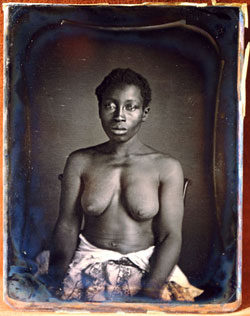

|
Very little is known about the young woman who sits for the camera here in 1850, near Charleston, South Carolina. We do know that she was a slave and that she had a name: Delia. She might have worked as a blacksmith on a plantation. This image may seem shocking to us now, and it certainly would have been at the time, too, if for perhaps different reasons: human beings were virtually never photographed naked in the United States, because it would have been seen as a severe violation of moral decency. But in this case, the famed Harvard biologist, Swiss-born Louis Agassiz (1807-1873), commissioned this daguerreotype (and several others like it) of an enslaved woman, Delia. As Molly Rogers has suggested, it is not correct to call this a portrait, because Delia, the sitter, had no choice in the matter, and it is not meant to portray her as a person. Instead, Agassiz intended to depict her as a type, an example of a racial kind and as an illustration for a biological theory of race he advocated. He had the local photographer, Joseph T. Zealy, make such images to provide visual evidence for his "polygenesis" thesis concerning the origins of the putatively different human races. (Not much is known about Zealy, but records show that he was active in Columbia, South Carolina from 1846 to 1859, with a short stint in Richmond, Virginia.) The polygenesis theory held that the differing races of human beings all had separate and distinct origins, not a single common ancestry, and that each racial type fit most properly into a climate and environment most suited to it. In short, Agassiz thought that human races were almost separate species, despite the fact that they could produce offspring together. Agassiz believed that an impartial viewer examining this image would simply "see" that the person in it could not be the same kind of human being as a European. Agassiz published his views in the most influential text advancing the polygenesis thesis: Types of Mankind (1854), by Josiah Mott and George Gliddon. An overview of the book and the theory of polygenesis may be read here. The whole book is available online here. Agassiz's contribution is entitled "Sketch -- Of the Natural Provinces of the Animal World and their Relation to the Different Types of Man," and it begins on page lviii of the book. The Peabody Museum at Harvard University, where the Zealy daguerreotypes commissioned by Agassiz are kept, records that a paper label accompanied this image of the slave, Delia; the label reads: “Delia, country born of African parents, daughter of Renty, Congo.” There is no positive identification of owner, but context suggests B.F. Taylor, who was the owner of Renty, the father of Delia. For Agassiz, it was significant that Delia came directly from unmixed African parentage, because she would then represent a pure "type." This image of Delia should be compared to another photograph in the Mirror of Race exhibition, a portrait of Agassiz. For an attempt at a reconstruction of Delia's life and circumstances, see the book by Molly Rogers, Delia's Tears: Race, Science, and Photography in Nineteenth-Century America (New Haven: Yale University Press, 2010). |